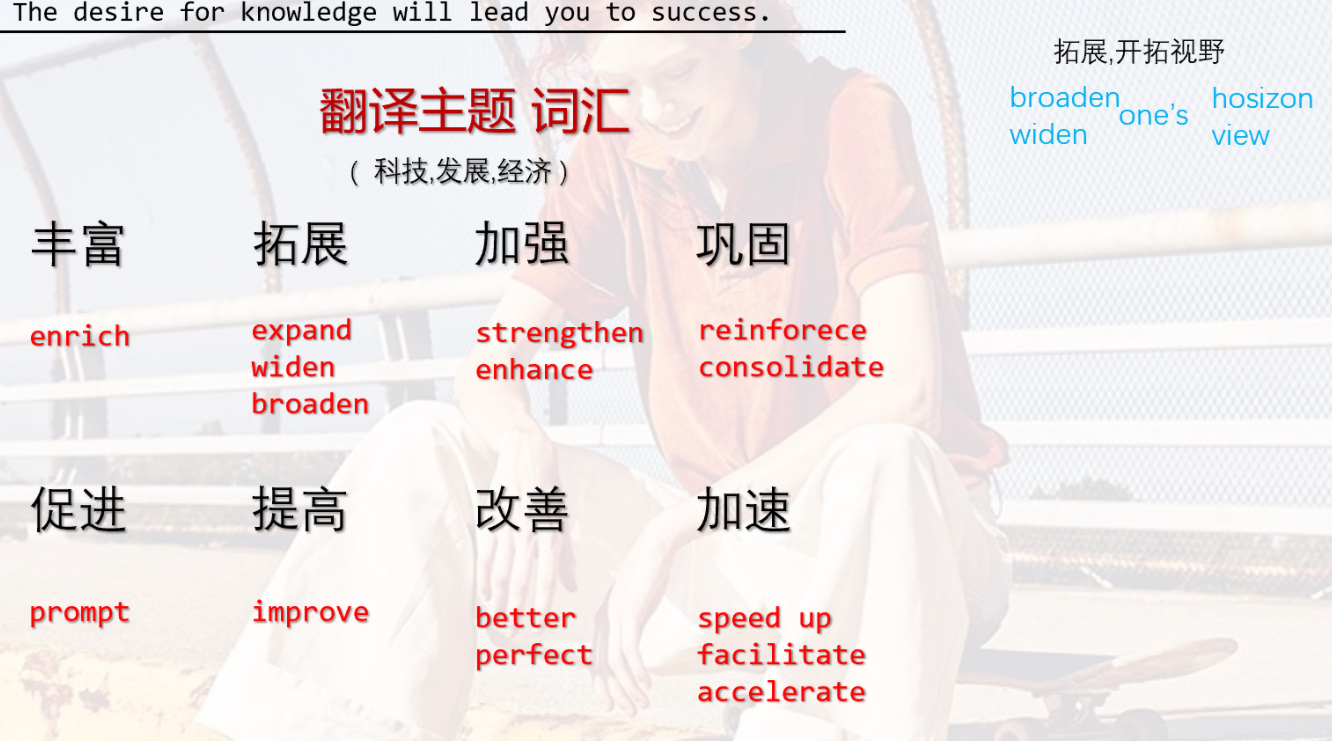CET4/6 | 专题 | 翻译
1. 什么是 翻译?
- 将 中文翻译为 合适的英文表达
题型简介: 自
2013年12月考次起, 全国大学英语四六级考试的翻译部分将由原单句汉译英调整为段落汉译英,翻译内容涉及中国的历史,文化,经济,社会发展等题材。
2. 翻译的目的是什么?
- 使得 学生具备了解中国文化,科技,发展的基本素质和向国际友人介绍的能力
3. 翻译涉及到哪些内容?
- 以本国文化背景为前提, 介绍给 别人
翻译的主题是 中国有关的主题或者 内涵,包括
①中国传统文化 (历史相关) --- chinese traditional culture
②自改革开放以来,中国的科学,技术,经济,社会发展 等题材 --- the reform and Opening-up of China.
⚠️ 因此必须掌握一些特殊词汇,或者表达,固定搭配,英语中的俗语,成语的表达( 所谓固定表达,就是一个基本不变的东西)
采取 "字眼法"
对应中文,是什么就记忆什么
例如「近年来」 ,固定的字眼,可以被视为一个符号,这样可以将 英语意思和 中文字形的表达,进行某种"捆绑" - 达到意会,形成 意群
需要总结和积累的东西
- 固定搭配
对于中文来说的一些成语,俗语(本身这个概念就是 "被封装的"),但是英语表达是"展开的",如 「著名景点」- famous scenic spots - 特定名词
如 the Great wall 单指 长城,等 文化差异不同导致 的 称呼
4. 意群
Q: 什么是意群?
意群是能完整表达一个含义,某种需求,目的的句子,词组群。
通俗来说: 意群就是 能把话,想要表达的意思说完喽
栗子: 中国人的姓名通常姓(family name)在前,名(give nname)在后。中国有10多亿个名字,所以人们即便在随意场合也可能会连名带姓地介绍自己,这是很寻常的。历史上,人名的受欢迎稈度会随着时事而变化。例如,20世纪80年代改革开放时期,“致富”成为一个名字,因其意为“变得富有”。
英语翻译: In China the family name is usually in front of the given name. It isn’t unusual for a man to introduce himself by his family name with given name even incasual situations because there are more than million given names. The Chinese given name has ahistory of changing with popularity depending on what events were going on. For instance,during the Cultural Revolution Hong (the color red) was very popular as it presents revolution. During the reform and opening up in the 1980s, Zhifu became one given name as it means “getting rich”.
意群01: 中国人的姓名通常姓(family name)在前,名(givenname)在后。
意群02: 中国有10多亿个名字,所以人们即便在随意场合也可能会连名带姓地介绍自己,这是很寻常的。
意群03: 历史上,人名的受欢迎稈度会随着时事而变化。
意群04: 例如,20世纪80年代改革开放时期,“致富”成为一个名字,因其意为“变得富有”。
意群01: In China the family name is usually in front of thegiven name.
意群02: It isn’t unusual for a man to introducehimself by his family name with given name even incasual situationsbecause there are more than abillion given names.
意群03: The Chinese given name has ahistory of changing with popularity depending on what events were going on.
意群04: For instance,during the Cultural Revolution Hong (the color red) was very popular as it presentsrevolution. During the reform and opening up in the 1980s, Zhifu became one given name asit means “getting rich”.
⚠️ 猜想: 中文中的句子区分是 按照意群区分 ; 而 英语中的句子区分是 按照 含有一个动词的句子区分。
一般思路,先根据中文意思的意群确定句子(看句号),后在这个范围内用英语翻译,允许有1~2句子(复合句)
5. 常见翻译表达标志
1、 "...与...存在差异" / "...和...不同"
- there be difference between ... and ...
- be different ... from ...
🧡 例句:
eg01: There are pretty clear differences between signs of dementia and age-related memorry loss . 【2018-cet4】
2、"有困难做...." / "在...上有麻烦"
sth have trouble doing
eg02: It is quite to have trouble remembering the names of people , places and things ... 【2018-cet4】
扩展: keep doing / sth - 保持...状态
3、 "具有...优点"
- sth/sb boasts ... such merits as ....
- have
/enjoys + posess
🧡例句:
eg03: subway boasts such merits as ....(地铁具有如下优点...)
👁️🗨️boasts v.有 (值得自豪的) , merit n.优点,美德,价值
4、" 越来越... "
- more and more [
一般表达] - growing (increasing) ....
概念上表示: ...增加
1)如果是名词,则是量(数量,质量)的增加 [不断地增多,增加]
2)如果是副词/形容词,则是 程度,幅度的增加 [不断的增强]
从数量上描述就是 ,需要注重概念的原意 (original intention)
🧡例句
eg04: 越来越多的人 ---- a growing number of pepoele...
eg05: 越来越多的城市 --- a growing number of cities...
eg06: 变得越来越便利 --- It is becoming increasingly convenient...
eg07: 越来越多的人选择地铁作为上班或上学的主要交通工具 --- An increasing number of people choose the subway as the main means of transportation to go to work or school.
扩展: such ... as ... (... 像 ... (诸如此类)) 举例子用
5、"能,有能力... " / "能够.."
- can
- be able to ...
- be capable of ....
6、表示时间,此时,当...
翻译为: "此时,在这时"
- as this point (在此时,表示前后关系很紧密)
- as doing
- when doing
7、通过...方式 ; 凭借...
- via 凭借 ( be means of )
- through (~ a place) 经由,经过(某一地方)
eg08: You can only achieve success through/via hard work.
你得孜孜不倦方能成功。
eg09: We flew home via Dubai.
我们乘飞机经迪拜回国。
6. 固定搭配
固定搭配 特指 不可替代 , 唯一表达,专业表达
7. 翻译主题词汇

来源: 博客园
作者: 茶哩哩
文章: 转载请注明原文链接:https://www.cnblogs.com/martin-1/p/14841895.html



【推荐】国内首个AI IDE,深度理解中文开发场景,立即下载体验Trae
【推荐】编程新体验,更懂你的AI,立即体验豆包MarsCode编程助手
【推荐】抖音旗下AI助手豆包,你的智能百科全书,全免费不限次数
【推荐】轻量又高性能的 SSH 工具 IShell:AI 加持,快人一步
· go语言实现终端里的倒计时
· 如何编写易于单元测试的代码
· 10年+ .NET Coder 心语,封装的思维:从隐藏、稳定开始理解其本质意义
· .NET Core 中如何实现缓存的预热?
· 从 HTTP 原因短语缺失研究 HTTP/2 和 HTTP/3 的设计差异
· 分享一个免费、快速、无限量使用的满血 DeepSeek R1 模型,支持深度思考和联网搜索!
· 使用C#创建一个MCP客户端
· 基于 Docker 搭建 FRP 内网穿透开源项目(很简单哒)
· ollama系列1:轻松3步本地部署deepseek,普通电脑可用
· 按钮权限的设计及实现